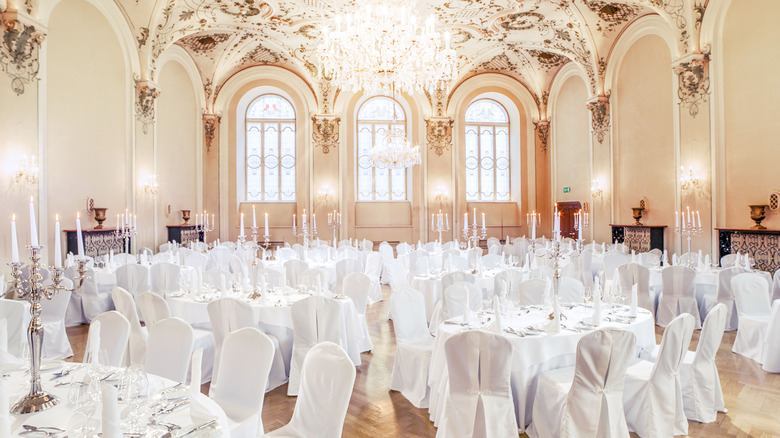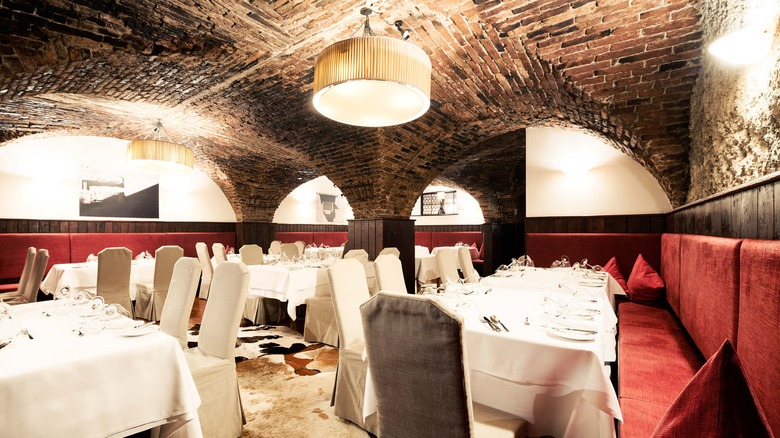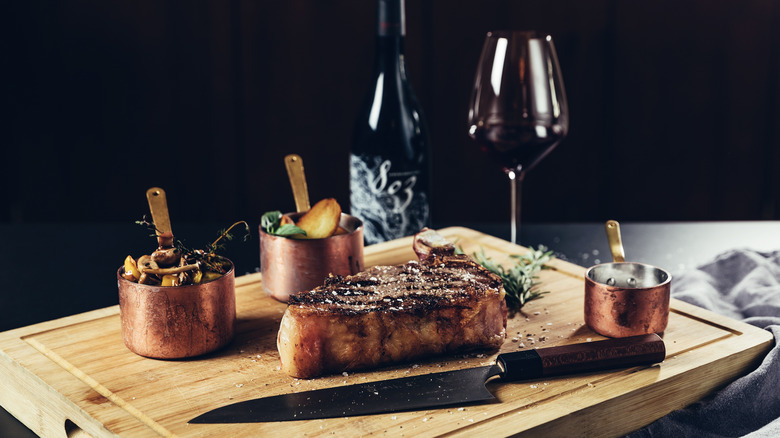The World's Oldest Restaurant Was Frequented By Mozart And Columbus
Located in the center of Salzburg, Austria's old town in the foothills of the Mönchsberg mountain, is the sprawling seventh-century Benedictine monastery complex of St. Peter's Abbey. Within the abbey's medieval walls, through a narrow archway, and past a landscaped courtyard, lies St. Peter Stiftskulinarium — officially recognized as the oldest existing restaurant in the world. Originally built as a wine cellar, then expanded into an inn and tavern servicing religious pilgrims and travelers, the restaurant was first mentioned in the year 803, making it over 1,220 years old. The accommodations are said to have hosted Christopher Columbus, Wolfgang Amadeus Mozart, and even the alchemist-magician Faust. In 1763, composer Michael Haydn, brother of Joseph Haydn, called the top floor of the inn his home.
Today, the restaurant is still visited by dignitaries and celebrities and is considered a cultural gathering place in the heart of the eastern Alps — the vast space fits up to 850 guests. Veronika Kirchmair and Claus Haslauer took out the first-ever lease on the property in the early 90s and have managed it ever since. The duo extensively redesigned the decor, renovated the kitchen and menus, and balanced it all with respect to historical context. The restaurant is now referred to simply as Peter, or St. Peter's, and along with offering Mediterranean cuisine and Austrian specialties in its opulently decorated rooms, is also home to a cocktail lounge and wine bar, special events, spectacular Christmas displays, and New Year's Eve galas.
Modern entertainment with old world charm
The St. Peter Stiftskulinarium was built directly into the adjoining mountain's rock face and its 11 themed rooms pay homage to its history. With juxtapositions of modern design against rock-hewn walls, each room is a feast for the eyes that matches the feasts served on its tables.
The Petrusstube room is situated in what was once the monastery's tavern. It features a rustic alpine theme replete with animal furs, mounted stag's heads, and crucifixes. The Richardstube room is a preserved brick vault built over 500 years ago as a rock wine cellar — where you can still enjoy fine wines to this day. The Haydnsaal is a small 18th-century banquet room with Baroque parquet ballroom floors and is where Michael Haydn once came daily to sip wine and compose music.
The Séparée Im Berg room is a moody space that sits entirely within the mountain and is surrounded by rock from floor to ceiling. It offers an intimate setting for business meetings and private gatherings. The Bürger-Prälatenstube is the Stiftskulinarium's oldest room, with dramatic coffered ceilings, dark wood paneling, and an overall elegance that links it to its past as a meeting place for church VIPs. The Willibaldarkaden is an outdoor space in the abbey's garden, partially enclosed by an elaborate domed arcade. Now it is used for receptions, banquets, art exhibits, and nightlife events.
An unforgettable classical music and fine dining experience
The majestic Barocksaal banquet hall at Peter is where its Mozart dinner concerts are held. The event transports visitors to 1790 — where under candlelit chandeliers and painted ceiling frescos, guests experience a dinner based on historical recipes — while musicians from the Amadeus Consort Salzburg perform the works of Mozart. The three-course menu starts with lemon chicken soup with curd cheese and rosemary dumplings. The main course is roasted capon on a red wine and herb glaze with polenta and vegetables, which the restaurant explains was originally a castrated rooster that it substitutes with corn-fed chicken. For dessert attendees are treated to Salzburger nockerl, a sweet souffle coaxed into resembling snow-flecked mountains.
The regular menu at Peter also boasts the extraordinary. Classic Austrian specialties include wiener schnitzel and tafelspitz — a boiled beef dish served in a traditional copper pan with horseradish. Appetizers like yellowfin tuna tartare and mango foam soup precede main courses such as veal goulash, venison medallions, chicken piccata, arctic char, mussels in tomato-vermouth sauce, homemade gnocchi, and lobster pasta. Dessert includes passionfruit tart with raspberry sorbet, crème brûlée, and apple strudel. The restaurant also has a dedicated steak menu with a selection of Austrian Simmentaler calf, U.S. Black Angus, and Wagyu beef. Weekend brunch serves breakfast and lunch favorites, with homemade bread and pastries, egg dishes, fish (Icelandic salmon), and a selection of spritzes, highballs, sparkling champagnes, craft cocktails, and mocktails.



